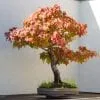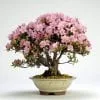Growing and sculpting a Fukien tea tree into a bonsai design is not a project for the beginner. While it offers many unique characteristics to the bonsai design, the Fukien tea tree is one of the more difficult varieties to sculpt.
Everything from cultivation, maintenance and pruning should be done by someone with experience. Of course, the end result of all this effort is paid back in full. For those up to the challenge, the Fukien tea tree promises a beautiful, graceful bonsai.
The Fukien tea tree is popular for bonsai because it easily develops a thick and knotted trunk, is evergreen, blooms frequently and has tiny lobed leaves. The trunk starts out thinner than desired for bonsai with young, light brown bark.
As the plant ages, the trunk thickens slowly, turns a light gray color and develops an attractive cracked appearance. The dark green, glossy leaves are covered in with small hairs and keep their luster all year round.
Each tiny leaf maintains its adorable size as the tree grows and is sculpted into a bonsai. Though small, the leaves of the Fukien tea tree make a thick, dense foliage in their prime.
Another reason the Fukien tea tree is ideal for bonsai is that it flowers regularly and offers small attractive blooms white and color and perfectly dainty.
This oriental plant will bloom almost every month of the year if given the right environment. As the blooms age, they turn into tiny round fruits. The fruits of a Fukien tea tree, usually appearing in early summer, can be green, red or black and visually appear quite similar to a rose hip, the fruit of the common rose plant, though smaller in size.
| Scientific/Botanical Name | Carmona retusa or Ehretia microphylla |
| Description | The Fukien tea tree is indigenous to Southeast Asia. It is distinguished by almost year-round white flowers that are small in structure. Blooms give way to small red, black or green berries that are akin to miniature rosehips. The deep green leaves are dainty and lustrous. They are covered with tiny hairs. |
| Position | If grown indoors, place the plant in a well-lit location. When grown outdoors, the tree can tolerate different light situations, from sunny to shady. It prefers warmth and humidity, and humidity mats can be used indoors to create optimal conditions. The plant needs to be protected in places where temperatures fall below 60o Fahrenheit. USDA zones 10 and 11 are ideal locations for growing the tree. |
| Watering | The tree is ideally grown in moist soil that is well-drained. It is best to allow the soil to dry slightly between watering. Over-watering will lead to root rot. Under-watering will cause the leaves to blacken and fall off. An indication of plant thirst is shriveled leaves. Water at the first sign of shriveling to refresh the tree and to maintain plant health. |
| Feeding | During the growing season, the plant should be fed once a week with a half-strength fertilizer that is specific to bonsai trees. Do not feed the plant for at least two weeks whenever the tree is re-potted or transplanted. |
| Leaf and Branch Pruning | Prune as desired for shaping and styling. The leaves are naturally small, so it is not necessary to prune for leaf size reduction. |
| Re-potting & Growing Medium | The tree requires re-potting every other year. This should be undertaken in the spring season. The use of a bonsai soil will ensure successful growth. |
| Wiring | It is not necessary to wire the plant but, if wiring is undertaken it should be for the shortest duration possible, and should not exceed three consecutive months. Prolonged wiring will dig into the tree and scar the trunk. |
| Notes | The tree is well-suited to the bonsai form, and makes a particularly stunning and floriferous specimen. |
Growing A Fukien Bonsai
A bonsai store, either online or in person, is the best place to look for a Fukien tea tree. Outside of these specialized stores, this variety of bonsai plant can actually be difficult to track down. When shopping for a Fukien tea tree, look for a plan that already has a thick trunk.
In fact, get the thickest trunk available. One of the biggest downsides to the Fukien tea tree for bonsai is that the trunk needs extra care to become as thick as desired. Choosing a Fukien tea tree that already has a thick trunk will improve the end results.
Fukien tea trees are not picky about the quality or make up of soil they are planted in, but it is essential that drainage is maintained at all times. The most common problem with Fukien bonsai is rotting roots from compacted, soggy soil.
The Fukien tea tree prefers soil that ranges from moist to slightly dry. The best practice for watering (link to watering page) a Fukien bonsai is to give it a good watering and then wait for days or weeks until the soil is getting dry before adding more liquid.
Under-watering a Fukien tea tree bonsai can result in the leaves looking shriveled. This can usually be reversed, if caught early, by watering the plant immediately. If water doesn’t arrive in time, the dried out leaves will turn black and drop off the plant. Expect regrown leaves in one to two months.
Sunlight is particularly important for growing a Fukien tea tree. In fact, making sure the plant gets enough direct sunlight each and every day should be the primary focus for anyone who doesn’t live in the desert.
A Fukien tea tree enjoys soft, gentle sunlight and temperatures from 60 to 77 degrees. To avoid the harshest sun rays, offer the afternoon sun to the Fukien tea tree instead of the brighter morning sun.
On the other hand, remember that the Fukien tea tree doesn’t like more than that one hour of direct sunshine. For the rest of daytime hours, place the plant out of direct sunlight but still in strong daylight.
Humidity is another important temperature concern when it comes to growing a healthy and attractive Fukien bonsai. Most people choose a humidity tray as a solution.
In dry climates, these measures are particularly important regardless of whether the plant is kept indoors, outdoors or is moved seasonally. In areas of the Midwest where humidity is the norm for summer weather, a humidity tray may only be necessary in the winter. In general, a Fukien bonsai refers humidity levels over 20%.
It’s a good idea to fertilize a Fukien tea tree every week with a half dilution of a bonsai specific fertilizer. It is important to fertilize whenever the plant is actively growing.
If the tree has recently been transplanted, transported or is otherwise in a time of transition, skip a week or two of fertilizing. For instance, a Fukien tea tree should be moved to a new planting pot every two years during spring. A recently transferred plant like this should not be fertilized as it adjusts to its new environment.
Inside Or Outside?
A Fukien tea tree should be kept indoors and in as much direct sunlight as possible. Native to China and India, this plant will not survive outdoors in temperate conditions. When there is not adequate sunlight for a Fukien tea tree to be happy, a fluorescent light can supplement.
Hang the bulb half a foot away from the top of the tree and keep it on for up to twelve hours each day. This solution is particularly important if the plant is not receiving any direct sunlight at all.
If a Fukien tea tree is kept outside during the summer, bringing it inside should be done in stages so as not to shock the plant. Well before the cold hits, move the plant first to a deck or other location cooler than its summer home.
After a few days there, move the plant inside but to a relatively cool part of the house so it can further adjust. In winter months, the daily hour of direct sunlight is still important. Regardless of the season, a Fukien tea tree should never be kept at temperatures lower than 55 degrees.
Conclusion
Fukien tea tree is the common name for this plant and comes from the name of a southeastern province in China where the plant originated. The Latin name is Carmona retusa and it is part of the Boraginaceae family, but the more modern scientific name is Ehretia buxifolia.
The Fukien tea tree also grows natively in India, Malaysia and the Philippines. In its native habitat, the Fukien tea tree is considered a small tree and can grow to be twelve feet tall!
An ideal house plant, bonsai project and piece of living art in progress, the Fukien tea tree presents an exciting and rewarding challenge.


